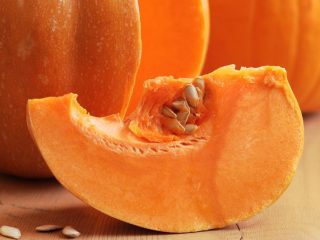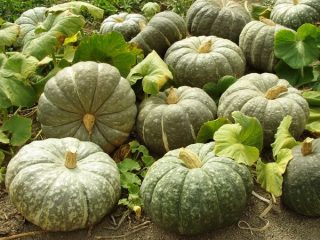Content
Pastila Champagne pumpkin was created by breeders on the basis of the Biotechnika agricultural company. The main direction in hybridization was the creation of a crop that produces a harvest regardless of weather conditions. The variety is grown in the temperate climate of the Moscow region, the Urals, and Siberia in unprotected soil.
Description of pumpkin Pastille Champagne
Pumpkin variety Pastila Champagne has a medium late ripening period, the fruits reach biological ripeness in 3 months. The plant is compact, with medium shoot formation. To save space on the site, it is recommended to install a support and tie up vines and fruits.
External characteristics of the pumpkin variety Pastila Champagne:
- The crop is tall, indeterminate, and requires height adjustment and bush formation. The shoots are thick with a ribbed structure, finely pubescent, light green. The whiskers are long and thick; when installing the trellis, they are completely removed.
- The leaves are round, five-lobed, attached to thick, short stalks. The leaf blade is bright green, slightly dissected, the veins are clearly defined, a shade darker than the leaf. The leaves are opposite, the foliage is medium.
- The flowers are large, bright yellow, bisexual.
The Champagne marshmallow variety is self-fertile and does not require pollinators.
Description of fruits
Pumpkin of the Pastila Champagne variety is distinguished by an unusual shape and color of the fruit for the crop. It is valued among vegetable growers for its gastronomic qualities.
Description of the fruits of the Pastila Champagne variety:
- elongated ellipse shape, weight – 2.5-3.5 kg;
- the surface is smooth, divided vertically into several segments, pink with small white fragments, mesh;
- the peel is hard, thin;
- the pulp is orange, dense, juicy;
- the seed sections are deep, located along the entire length of the fruit, the seeds are white, flat, small.
The taste of the Pastila Champagne pumpkin is sweet with a vanilla aroma. Fruits of universal use, consumed fresh. Processed into juice and puree. Pumpkin is stewed, baked, cooked in a steam bath, and used to prepare rice or millet porridge.
This variety of pumpkin is grown in the country, in the garden, and is suitable for commercial cultivation in large farm areas. It tolerates transportation well over long distances.
Characteristics of the variety
Pumpkin variety Pastila Champagne was created specifically for growing in temperate climates. The herbaceous plant does not stop growing at +160 C. The indicator indicates the frost resistance of the variety. Pumpkins are planted in the area when there is no threat of frost; young shoots are rarely damaged by frost. If young shoots freeze, the crop recovers well, and the negative impact does not affect the timing and level of fruiting. The fruits ripen simultaneously, have an even shape, and are harvested in late August or mid-September.
Pumpkin Pastila Champagne is a heat-loving plant; excess ultraviolet radiation is required for the growing season. In a shaded area, the pumpkin stops blooming, the ovaries crumble, and productivity is low. A place exposed to the north wind is not suitable for cultivation. Pumpkin has average drought resistance; the plant requires watering. At the same time, it does not tolerate waterlogging of the soil; the root system is superficial and prone to rotting. Prefers neutral soil, fertile, without stagnant water. The best option for growing is drained sandy loam soil.
A bush of the Pastila Champagne variety is formed with two shoots - the main and the first stepson. The lateral processes are removed as they form. 5 ovaries are left on one bush, distributed between the stems, and the remaining flowers and fruits are removed. Thus, the plant is unloaded. All nutrients are aimed at ripening the fruit. At 1 m2 2-3 plants are planted, the average yield is about 20 kg.
Resistance to pests and diseases
The most common pest on Pastille Champagne pumpkin is aphids. Appears in mid-summer, the main place of localization of insects is the lower part of the leaf and flowers. The leaves where aphids accumulate turn yellow and curl, and the flowers fall off. To get rid of the pest, make a solution. Ingredients for 10 liters of water:
- onion minced – 200 g;
- red pepper – 4 tbsp. l;
- wood ash – 50 g;
- liquid soap (laundry) – 50 g.
The substance is filtered, the bush is treated, and after 5 days the procedure is repeated.
If the method does not give a positive result, the culture is sprayed with the drug “Fitoverm” or “Iskra” and diluted according to the instructions for the product.
Whitefly parasitizes less often; “Commander” will help get rid of it.
When the soil is waterlogged and the planting is dense, bacterial rot of the fruit develops. It affects the plant at any stage of the growing season, the stalk darkens, then the fruit falls off. To eliminate bacterial infection, reduce watering, remove infected areas, and treat with Hom.
It is possible to develop a fungal disease - powdery mildew. It appears as white spots on the leaves, these places dry out, the leaves die off. Colloidal sulfur and the drug “Topaz” are used against the fungus.
Advantages and disadvantages
According to reviews from vegetable growers, the Pastila Champagne pumpkin variety has proven itself only on the good side over many years of cultivation:
- frost-resistant, yield is not affected by lower temperatures;
- manages to ripen in short summer conditions and in regions with a temperate climate;
- does not require special care;
- can be grown both with and without a trellis;
- the fruits have an exotic appearance;
- universal in use;
- retains its presentation for a long time;
- suitable for commercial cultivation;
- has good taste and aroma;
- provides complete planting material.
The disadvantages include the fact that pumpkin is intolerant to waterlogging of the soil. Resistance to pests and diseases is average. It is necessary to change the seeds every 3 years.
Growing technology
The Pastila Champagne variety is grown on the site by direct planting of seeds in the ground. Plants do not take root well after transplanting. The seedling method is used in regions with a colder climate than, for example, in Central Russia, as well as with short summers. The seedling method will help shorten the ripening period.To plant seeds for seedlings, they are first germinated. Wrap in a wet cloth and leave in a warm place. After 4-5 days, sprouts will appear. Follow up work:
- Fertile soil is poured into plastic or peat cups.
- Make a 3 cm indentation.
- Carefully, so as not to damage the sprout, place the seed at the rate of 1 seed per 1 container.
- Water, place in a box or container, cover with film.
- They are removed to a lighted room.
After the growth appears, the film is removed. Planting takes place in early April.
Pumpkins are planted on the plot at the end of May, provided that the ground has warmed up to +160 C, the timing is the same for seedlings and direct planting. Before direct planting, the seeds are selected, placed in the refrigerator for 10 days, then germinated.
Planting work:
- The area is being dug up.
- Remove any remaining grass.
- Organic matter and urea are added.
- Ash and seeds are placed in each hole, watered, and covered.
Layout: row spacing – 1.5 m, distance between pumpkins – 75 cm.
Aftercare:
- The plant is watered every evening with a small amount of water until the fruits form. The volume of liquid increases as you grow. After the first garter of plants, watering is reduced to 2 times a week, the root circle is mulched with straw or compost.
- Side shoots, tendrils and dry leaves are removed and formed into two stems.
- The bush is tied up and excess ovaries are removed.
- The Pastila Champagne variety is fed with organic matter and phosphate, and potassium is added a month before harvesting. Organic matter can be added without restrictions; excess will not harm the pumpkin.
- Weeding and loosening is carried out as it grows weed.
For preventive purposes, planting varieties are sprayed with an antifungal drug. Harvest in September.When the stalk dries, pick the pumpkin along with it. With a stalk, fruits are stored longer. After harvesting, the pumpkin is placed in a room with good ventilation, air humidity - 85%, temperature - +5-100 C.
Conclusion
Pumpkin Pastila Champagne is a frost-resistant variety with a medium-late ripening period. A culture was created for open ground; it is grown in the European and central parts of Russia. The fruits are universal in use, have a sweet banana taste and a subtle vanilla aroma. Pumpkin is suitable for growing in large and small areas. The hallmark of the variety is the unusual shape and color of the fruit.











